
The Sea of Okhotsk is a marginal sea of the western Pacific Ocean. It is located between Russia's Kamchatka Peninsula on the east, the Kuril Islands on the southeast, Japan's island of Hokkaido on the south, the island of Sakhalin along the west, and a stretch of eastern Siberian coast along the west and north. The northeast corner is the Shelikhov Gulf. The sea is named after Okhotsk, the first Russian settlement in the Far East.

Sakhalin is the northernmost island of the Japanese archipelago and the largest island of the Russian Federation. It is situated in the North Pacific Ocean between 45°50' and 54°24' N, and is sandwiched between the Sea of Okhotsk to the east and the Sea of Japan to the west. It is administered as part of Sakhalin Oblast. Sakhalin, which is about one third the size of Honshu, is just off the Russian Pacific coast, and just north of the Japanese island of Hokkaido. The population of Sakhalin Island was 497,973 as of the 2010 census, made up of mostly ethnic Russians and a smaller Korean community. The indigenous peoples of the island are the Ainu, Oroks and Nivkhs.
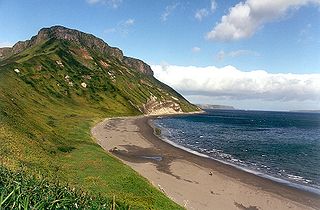
The Kuril Islands or Kurile Islands is a volcanic archipelago in Russia's Sakhalin Oblast that stretches approximately 1,300 km (810 mi) northeast from Hokkaido, Japan to Kamchatka, Russia, separating the Sea of Okhotsk from the north Pacific Ocean. There are 56 islands and many minor rocks. It consists of the Greater Kuril Chain and the Lesser Kuril Chain. The total land area is 10,503.2 square kilometres (4,055.3 sq mi), and the total population is 19,434.

The Kuril Islands dispute, also known in Japan as the Northern Territories dispute, is a disagreement between Japan and Russia and also some individuals of the Ainu people over sovereignty of the four southernmost Kuril Islands. The Kuril Islands is a chain of islands that stretch between the Japanese island of Hokkaido at the southern end and the Russian Kamchatka Peninsula at the northern end. The islands separate the Sea of Okhotsk from the Pacific Ocean. The four disputed islands, like other islands in the Kuril chain that are not in dispute, were annexed by the Soviet Union following the Kuril Islands landing operation at the end of World War II. The disputed islands are under Russian administration as the South Kuril District of the Sakhalin Oblast. They are claimed by Japan, which refers to them as its Northern Territories or Southern Chishima, and considers them part of the Nemuro Subprefecture of Hokkaido Prefecture.

The Treaty of Saint Petersburg between the Empire of Japan and Empire of Russia was signed on 7 May 1875, and its ratifications exchanged at Tokyo on 22 August 1875. The treaty itself went into effect in 1877.

Atlasov Island, known in Russian as Ostrov Atlasova (Остров Атласова), or in Japanese as Araido (阿頼度島), is the northernmost island and volcano and also the highest volcano of the Kuril islands, part of the Sakhalin Oblast in Russia. The Russian name is sometimes rendered in English as Atlasova Island. Other names for the island include Uyakhuzhach, Oyakoba and Alaid, the name of the volcano on the island.

Sakhalin Oblast is a federal subject of Russia comprising the island of Sakhalin and the Kuril Islands in the Russian Far East. The oblast has an area of 87,100 square kilometers (33,600 sq mi). Its administrative center and largest city is Yuzhno-Sakhalinsk. As of the 2010 Census, the oblast has a population of 497,973. Besides people from other parts of the former Soviet Union and the Korean Peninsula, the oblast is home to Nivkhs and Ainu, with the latter having lost their language in Sakhalin recently. Sakhalin is rich in natural gas and oil, and is Russia's fourth wealthiest federal subject and wealthiest oblast. It borders Khabarovsk Krai to the west and Kamchatka Krai to the north, along with Hokkaido, Japan to the south.

Karafuto Prefecture, commonly known as South Sakhalin, was a prefecture of Japan located in Sakhalin from 1907 to 1949.
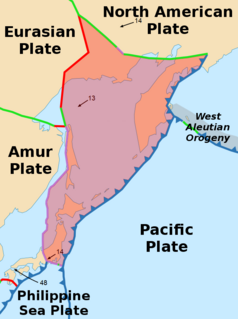
The Okhotsk Plate is a minor tectonic plate covering the Kamchatka Peninsula, Magadan Oblast, and Sakhalin Island of Russia; Hokkaido, Kantō and Tōhoku regions of Japan; the Sea of Okhotsk, as well as the disputed Kuril Islands. It was formerly considered a part of the North American Plate, but recent studies indicate that it is an independent plate, bounded on the north by the North American Plate. The boundary is a left-lateral moving transform fault, the Ulakhan Fault. On the east, the plate is bounded by the Pacific Plate at the Kuril-Kamchatka Trench and the Japan Trench, on the south by the Philippine Sea Plate at the Nankai Trough, on the west by the Eurasian Plate, and possibly on the southwest by the Amurian Plate.

The buff ermine is a moth of the family Erebidae. It is sometimes placed in the genus Spilosoma. The species was first described by Johann Siegfried Hufnagel in 1766. It is found throughout the temperate belt of the Palearctic region south to northern Turkey, Georgia, Kazakhstan, southern Siberia, eastern Mongolia, Amur Region, China, Korea and Japan.
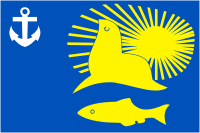
Nevelsk is a port town and the administrative center of Nevelsky District of Sakhalin Oblast, Russia, located on the southwest coast of the Sakhalin Island, 123 kilometers (76 mi) from Yuzhno-Sakhalinsk, the administrative center of the oblast. Population: 11,682 (2010 Census); 18,639 (2002 Census); 24,236 (1989 Census).
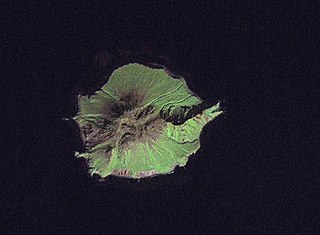
Antsiferov Island is an uninhabited volcanic island located in the northern Kuril Islands chain in the Sea of Okhotsk in the northwest Pacific Ocean. Its former Japanese name is derived from the Ainu language for "place of tall waves". Its nearest neighbor is Paramushir, located 15 km away across the Luzhin Strait. It is currently named for the cossack explorer Danila Antsiferov, who first described it along with other northern Kuril islands in the early eighteenth century.
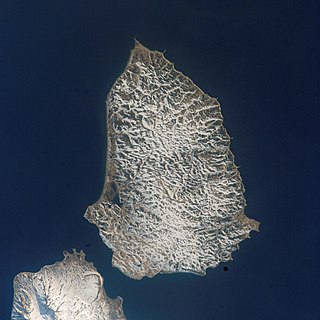
Shumshu is the second-northernmost island of the Kuril Islands chain, which divides the Sea of Okhotsk from the northwest Pacific Ocean. The name of the island is derived from the Ainu language, meaning "good island". It is separated from Paramushir by the very narrow Second Kuril Strait in the northeast 2.5 kilometres (1.6 mi), and its northern tip is 11 kilometres (6.8 mi), from Cape Lopatka at the southern tip of the Kamchatka Peninsula. The island has a seasonal population of around 100 inhabitants.

Phragmatobia fuliginosa, the ruby tiger, is a moth of the family Erebidae.

Laothoe amurensis, the aspen hawk-moth, is a moth of the family Sphingidae.

Phragmatobia is a genus of moths in the subfamily Arctiinae described by Stephens in 1828. Many tiger-moth species of small and medium size were described within this genus. However, only a few are related to the type species.

The Ainu in Russia are an indigenous people of Russia located in Sakhalin Oblast, Khabarovsk Krai and Kamchatka Krai. The Russian Ainu people, also called Kurile, Kamchatka's Kurile or Eine, can be subdivided into six groups.
Spilarctia seriatopunctata is a moth in the family Erebidae. It was described by Motschulsky in 1861. It is found in Russia, China, Korea and Japan.

The Japan–Russia border is the de facto maritime boundary that separates the territorial waters of the two countries. According to the Russia border agency, the border's length is 194.3 km (120.7 mi).
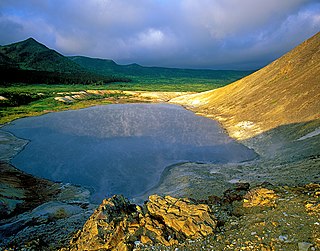
Kurils Nature Reserve is a Russian 'zapovednik' covering the north and south portions of Kunashir Island, the largest and most southernmost of the Kuril Islands, which stretch between Hokkaido Island in Japan to the Kamchatka peninsula in the Russia Far East. It also covers two smaller islands nearby to the southeast. The area is one of the largest wintering sites for coastal seabirds. The reserve sits on a tectonically unstable location, and is one of two Russian national reserves that protects territory of active volcanoes. The reserve is situated in the Yuzhno-Kurilsky District of Sakhalin Oblast. The reserve was created in 1984, and covers an area of 65,364 ha (252.37 sq mi).


















